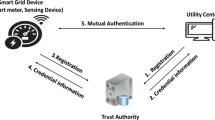Abstract
The authenticated key agreement (AKA) protocol is an important cryptographic mechanism, which allows two users to establish a session key for future communication. Recently, the certificateless public key cryptography received wide attention since it could solve the certificate management problem in the traditional public key cryptography and solve the key escrow problem in the identity-based public key cryptography. In this paper, we present a strongly secure certificateless authenticated key agreement (CLAKA) protocol without pairing suitable for smart media and mobile environments, which is provably secure in the extended Canetti–Krawczyk (eCK) model and is secure as long as each party has at least one uncompromised secret. Compared with previous CLAKA protocols, our protocol has advantages over them in security or efficiency.

Similar content being viewed by others
References
Al-Riyami S, Paterson KG (2003) Certificateless public key cryptography. In: Proc. of ASIACRYPT 2003, LNCS 2894, Springer-Verlag, pp 452–473
Bellare M, Pointcheval D, Rogaway P (2000) Authenticated key exchange secure against dictionary attacks. In: Proc.of the EUROCRYPT 2000. LNCS, Springer-Verlag, Vol. 1807, pp 139–55
Bellare M, Rogaway P (1993) Entity authentication and key distribution. In: Proc. of the CRYPTO 1993. LNCS, Springer-Verlag, Vol. 773, pp 232–49
Bellare M, Rogaway P (1995) Provably secure session key distribution: the three party case. In: Proc. of the 27th ACM symposium on the theory of computing, ACM, pp 57–66
Canetti R, Krawczyk H (2001) Analysis of key-exchange protocols and their use for building secure channels. In: Proc. of the EUROCRYPT 2001. LNCS, Springer-Verlag, Vol. 245, pp 453–74
Cao X, Kou W (2010) A pairing-free identity-based authenticated Key agreement scheme with minimal message exchanges. Inf Sci 180:2895–2903
Chen L, Cheng Z, Smart NP (2007) Identity-based key agreement protocols from pairings. Int J Inf Secur 6:213–241
Geng M, Zhang F (2009) Provably secure certificateless two-party authenticated key agreement protocol without pairing. In: Proc. of International Conference on Computational Intelligence and Security, pp 208–212
He D, Chen Y, Chen J, Zhang R, Han W (2011) A new two-round certificateless authenticated key agreement protocol without bilinear pairings. Math Comput Model 54(11–12):3143–3152
He D, Chen J, Hu J (2012) A pairing-free certificateless authenticated key agreement protocol. Int J Commun Syst 25(2):221–230
He D, Padhye S, Chen J (2012) An efficient certificateless authenticated key agreement protocol. Comput Math Appl 64(6):1914–1926
Hou M, Xu Q (2009) A two-party certificateless authenticated key agreement protocol without pairing. In: Proc. of 2nd IEEE International Conference on Computer Science and Information Technology, pp 412–416
LaMacchia BA, Lauter K, Mityagin A (2007) Stronger security of authenticated key exchange. In: Proc. of the ProvSection 2007. LNCS, Springer-Verlag , Vol. 4784, pp 1–16
Lippold G, Boyd C, Nieto J (2009) Strongly secure certificateless key agreement. In: Pairing 2009, pp 206–230
Mandt T, Tan C (2008) Certificateless authenticated two-party key agreement protocols. In: Proc. of the ASIAN 2006, LNCS, Springer-Verlag, Vol. 4435, pp 37–44
Ni L, Chen G, Li J, Hao Y (2011) Strongly secure identity-based authenticated key agreement protocols. Comput Electr Eng 37:205–217
Shamir A (1984) Identity-based cryptosystems and signature protocols. Proc. CRYPTO1984, LNCS, Vol. 196, pp 47–53
Shao Z (2005) Efficient authenticated key agreement protocol using self-certifed public keys from pairings. Wuhan Univ J Nat Sci 10(1):267–270
Shi Y, Li J (2007) Two-party authenticated key agreement in certificateless public key cryptography. Wuhan Univ J Nat Sci 12(1):71–74
Swanson C (2008) Security in key agreement: Two-party certificateless protocols, Master Thesis, University of Waterloo
Wang S, Cao Z, Dong X (2006) Certificateless authenticated key agreement based on the MTI/CO protocol. J Inf Comput Sci 3:575–581
Yang G, Tan C (2011) Strongly secure certificateless key exchange without pairing. In: Proc. of 6th ACM Symposium on Information, Computer and Communications Security, pp 71–79
Zhang L, Zhang F, Wua Q, Domingo-Ferrer J (2010) Simulatable certificateless two-party authenticated key agreement protocol. Inf Sci 180:1020–1030
Acknowledgments
This research was supported by Basic Science Research Program through the National Research Foundation of Korea (NRF) funded by the Ministry of Education (grant number 2013R1A1A2059864).
Author information
Authors and Affiliations
Corresponding author
Rights and permissions
About this article
Cite this article
Tu, H., Kumar, N., Kim, J. et al. A strongly secure pairing-free certificateless authenticated key agreement protocol suitable for smart media and mobile environments. Multimed Tools Appl 74, 6365–6377 (2015). https://doi.org/10.1007/s11042-015-2470-3
Received:
Accepted:
Published:
Issue Date:
DOI: https://doi.org/10.1007/s11042-015-2470-3




